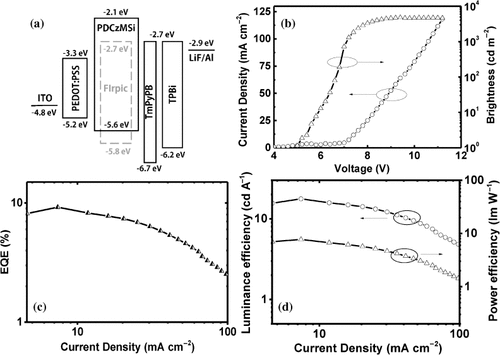
Oligosiloxane Functionalized with Pendant (1,3‐Bis(9‐carbazolyl)benzene) (mCP) for Solution‐Processed Organic Electronics
Dianming Sun, Zhaomin Yang, Zhongjie Ren, Huihui Li, Martin R. Bryce, Dongge Ma, Shouke Yan
Abstract : A new oligosiloxane derivative (ODCzMSi) functionalized with the well‐known 1,3‐bis(9‐carbazolyl)benzene (mCP) pendant moiety, directly linked to the silicon atom of the oligosiloxane backbone, has been synthesized and characterized. Compared to mCP, the attachment of the oligosiloxane chain significantly improves the thermal and morphological stabilities with a high decomposition temperature (Td=540 °C) and glass transition temperature (Tg=142 °C). The silicon–oxygen linkage of ODCzMSi disrupts the backbone conjugation and maintains a high triplet energy level (ET=3.0 eV). A phosphorescent organic light‐emitting diode (PhOLED) using iridium bis(4,6‐difluorophenyl)pyridinato‐N,C2 picolinate (FIrpic) as the emitter and ODCzMSi as the host shows a relatively low turn‐on voltage of 5.0 V for solution‐processed PhOLEDs, maximum external quantum efficiency of 9.2 %, and maximum current efficiency of 17.7 cd A−1. The overall performance of this device is competitive with the best reported solution‐processed blue PhOLEDs. Memory devices using ODCzMSi as an active layer exhibit non‐volatile write‐once read‐many‐times (WORM) characteristics with high stability in retention time up to 104 s and a low switch on voltage. This switching behaviour is explained by different stable conformations of ODCzMSi with high or low conductivity states which are obtained under the action of electric field through a π–π stacking alignment of the pendant aromatic groups. These results with both PhOLEDs and memory devices demonstrate that this oligosiloxane–mCP hybrid structure is promising and versatile for high performance solution‐processed optoelectronic applications.
